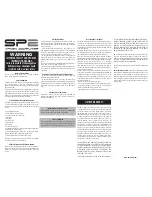
16
4.3 Load Couples into Power Line
Occasionally, an antenna will strongly couple into nearby power lines (e.g. a longwire
antenna in the attic). When this occurs, the plot lines may be “thicker” and the readings will
shift around a lot. There are two methods to eliminate this effect
1. Power the VIA Bravo from batteries. The wall power pack must be unplugged from the
VIA Bravo power jack to do this.
2. Connect the ground sleeve of the coaxial connector to an earth ground.
If the above methods do not clear up the plots, there is most likely an interfering signal
causing the problem.
4.4 Tune an antenna to resonance
To tune an antenna to resonance, set the VIA Bravo center frequency to the desired resonant
frequency. Connect the VIA Bravo to the antenna. Using the adjustment provided by the
antenna manufacturer, tune the antenna for a zero phase crossing at the VIA Bravo center
frequency. The tuning adjustment could be one of several methods, and should be mentioned in
the instructions for the antenna. The antenna’s resonant impedance (Z) can then be read on the
other plot.
4.5 Measure the length of a coax
To find the length in degrees (at some frequency) set the instrument mode to SWR and
one of the plot-types to Reflection coefficient angle (see paragraphs 3.9.1.2 and 3.9.1.2.4 ).
Set the VIA Bravo MRI center frequency to the frequency of interest. Note the RCA reading.
By adjusting the sweep width to the widest, and stepping through a number of center
frequency values, determine how many positive to negative zero crossings there are below
the frequency of interest. The length in degrees is:
L = (180)(number of zero crossings) + modified RCA
Calculate the modified RCA using this algorithm: if the RCA is positive then subtract off
360 from RCA (if RCA is negative, don’t subtract anything). Now multiply the new RCA by
negative ½. The result will be a number between 0 and +180.
To convert the length to wavelengths, divide L by 360.
EXAMPLE:
I have chosen 14.7 MHz as this is the operating frequency of one of the MRI systems we have
used during testing. We want to measure a coax that disappears into a wall panel and comes
out the other side of a room, so we do not know it’s actual length. We have reason to believe that
the velocity factor of this coax is the standard .66, but this in not really important since this
calculation is based, already, on measurements with velocity incorporated. To give the
measurement in feet would require Vf .
By stepping through several sweep widths and center frequencies I have determined that there
are only 2 positive-to-negative zero crossings and the RCA value is – 46 degrees. Using the
formula from above we start with multiplying 180 times 2 (crossings)= 360. Since the RCA is
already negative, we do not need to subtract out 360 from our number of –43. The Mod-RCA
number is = -46 times –1/2, or +23. To finish out the calculation we add the first half of 360 to the
Mod-RCA of 23 to get 383 degrees.
To get wavelengths we divide by 360 to get 1.0639.
To convert to feet we do the following:
Divide 982.08 by 14.7 (MHz) = 66.808Ft. (wavelength in air), times Vf (.66) = 44.093 ft (in coax).
Multiply our L of 1.0639 times 44.093 = 46.911 Ft or just short of 46 Feet 11 inches. The plans
called for 1 ½ wavelengths, so I think we have a problem to look for.
Содержание VIA Bravo MRI
Страница 1: ...MRI Network Analyzer MRI Network Analyzer 100KHz to 70 MHz ...
Страница 42: ...38 NOTES ...
Страница 43: ...39 NOTES ...
















































